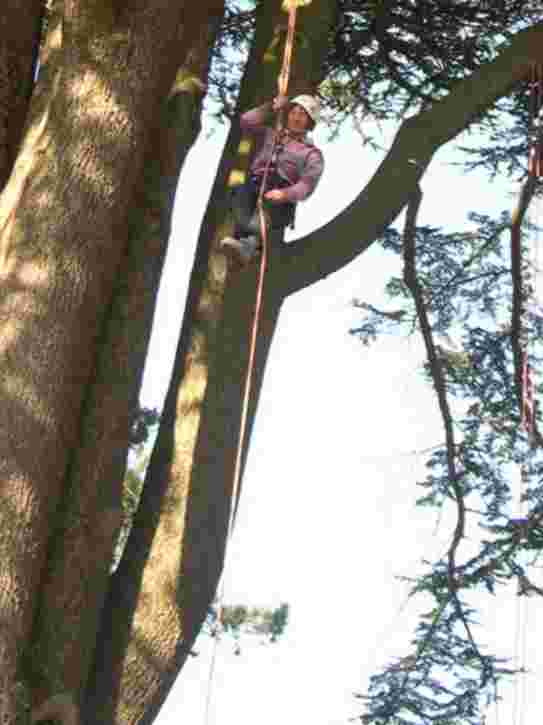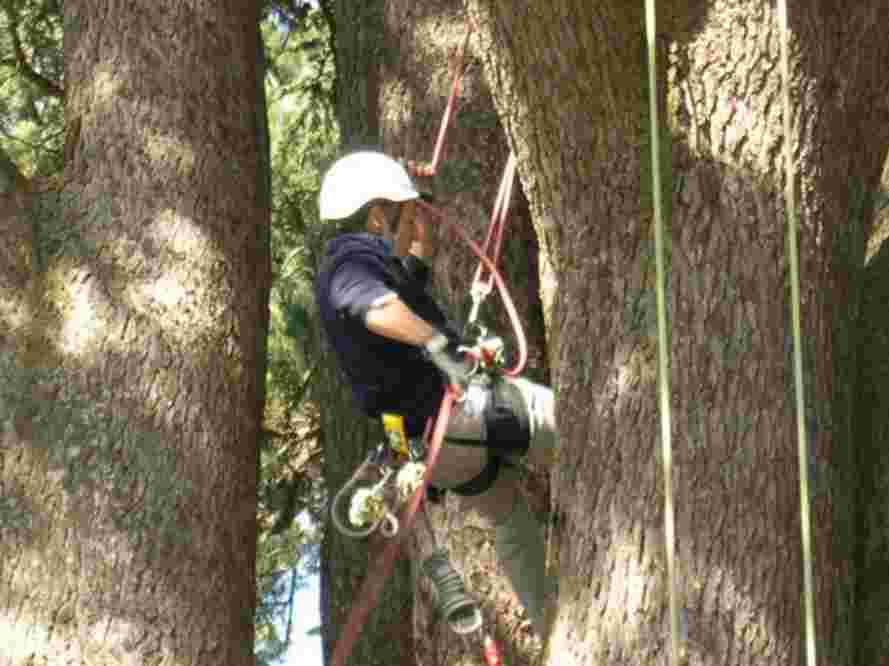TREE CONSULTANTS AND TREE CONTRACTORS
Choosing and Appointing a Tree Consultant or Tree Contractor
Landowners are responsible for having their trees checked regularly, and for making sure that any necessary works are carried out, to ensure that they do not cause injury to people or damage to property. (It is also sensible to have trees included on your building insurance policy). The Isle of Wight Council Tree Team compiles A LIST to help people choose consultants and contractors.
It is not an approved list, nor is it a guarantee of quality or service. It is your responsibility to check before you appoint somebody.
Check qualifications and current insurance as detailed on this list, and ask about experience, and health & safety policies and procedures. All firms are required by law to have a health and safety policy, which must be written if the firm employs five or more people. Ask for references, and look at similar work they have done elsewhere. Discuss what you want done and why. You may want to ask two or three companies for quotations, but do not necessarily choose the cheapest - they may not be the best value for money.
| Tree work is hard, skilled work and potentially very dangerous. It should only be done by people who have been trained to do it. The Provision and Use of Work Equipment Regulations 1998 (PUWER 98) requires anyone working with chainsaws on or in trees to be competent to do so. They should have received appropriate training and obtained a relevant certificate of competence or national competence award. |  |
Somebody paid to work with chainsaws on or in trees who has not been trained to do so is breaking the law.
It is suggested that tree contractors should do refresher training every five years. Tree work is also covered by the Lifting Operations and Lifting Equipment Regulations 1998 (LOLER 98). Guidelines for tree work were set by FASTCo, the Forestry & Arboriculture Safety & Training Council.
If contractors are not properly trained, or they do not follow industry guidelines, then their insurance will almost certainly be invalid.
 | Tree surgery also needs to be done by people who understand what they’re doing and why - tree contractors should know their trees well, and for each species know how to recognise a typical sound healthy tree so that they will recognise an unsound one, and know how different species respond to their environment and to pruning. Last but not least, perhaps the most important requirement for good tree surgery is a feel for the shape and the beauty of the tree. |
Ask to see similar trees that the contractor has pruned before.
A good tree surgeon is artistic and can see how to prune the tree to leave it not only healthy and sound, but also with a beautiful natural shape.
A good tree surgeon is artistic and can see how to prune the tree to leave it not only healthy and sound, but also with a beautiful natural shape.
What information is used to produce this list?
All the contractors on the list have provided photocopies of certificates of insurance, and of relevant training and qualifications.
The list is divided into three parts:
The list is divided into three parts:
- Tree consultants.
- Tree contractors.
- Timber merchants.
NPTC Certificates
One of the most widely recognized training schemes for tree work is set by the National Proficiency Tests Council. Tree contractors who have passed NPTC assessments carry an ID card.
- For felling only, units CS 30 (Maintain the Chain Saw), and CS 31 (Fell Small Trees) are enough for trees up to 8 - 15" diameter; CS 30 and CS 32 (Fell Medium Sized Trees) for trees 15 - 30" diameter; CS 30 and CS 33 (Fell Large Trees) for trees over 30" diameter. For each of these, “A” after the unit means conifers, and “B” means broadleaves.
- For felling trees in sections (dismantling), from small spaces where there is not room to fell a whole tree in one go, you should only employ a contractor with staff who have passed unit CS 41 (Carry out Dismantling Operations).
- For pruning (tree surgery), you should only employ a contractor with staff who have passed unit CS 40 (Carry out Pruning Operations).
| Before they can take unit CS 40 or CS 41, tree contractors must have been trained to climb and rescue people from trees, and to climb and use a chainsaw in trees. These are covered by unit CS 38 (Climb Trees and Perform Aerial Tree Rescue), and CS 39 (Operate the Chainsaw from a Rope and Harness). Again, contractors have to pass CS 30, CS 31 or CS 37 before they can do CS 38 or CS 39, so that somebody who has CS 40 or CS 41 will also have passed CS 30, CS 31 or CS 37, CS 38, and CS 39. |  |
Only people who have been trained to do so should use a chainsaw in a tree - in other words people with CS 39 (CS 22 up to 1996), CS 40, or CS 41.
If one member of the team is climbing, there should always be at least one other member of the team who is trained in climbing and aerial rescue, in case the climber is injured - in other words, somebody with CS 38, CS 39, CS 40, or CS 41.
Summary of NPTC chainsaw units
For guidance only - for full details contact NPTC.Numbering and precise unit details have changed over the years, so equivalent old units are also shown.
| | |||
| current unit number | (equivalent or approximately equivalent to old unit number) | | units which must be passed before this one can be taken |
| | |||
| CS 30 | CS 10 | maintain the chain saw | - |
| CS 31a | part of CS 11 | fell small trees (conifer) | CS 30 |
| CS 31b | part of CS 11 | fell small trees (broadleaf) | CS 30 |
| CS 32 a | part of CS 12 | fell medium trees (conifer) | CS 31 |
| CS 32 b | part of CS 12 | fell medium trees (broadleaf) | CS 31 |
| CS 33 a | part of CS 13 | fell large trees (conifer) | CS 32 |
| CS 33 b | part of CS 13 | fell large trees (broadleaf) | CS 32 |
| CS 34 | part of CS 14 | clear individual windblown trees | CS 32 |
| CS 35 | part of CS 14 | clear multiple windblown trees | CS 32 |
| CS 36 | CS 16, parts of CS 11, 12, 13 | cross-cut and stack produce | CS 30 |
| CS 37 | part of CS 12, CS 13, CS 21 | breakdown medium sized broad-leafed crowns | CS 36 |
| CS 38 | SCOTVEC 88157 | climb trees and perform aerial rescue | - |
| CS 39 | CS 22 | operate the chainsaw from a rope and harness | CS 38, either CS 31 or CS 37 |
| CS 40 | AA 8 | carry out pruning operations | CS 38, CS 39 |
| CS 41 | AA 9 | carry out dismantling operations | CS 38, CS 39 |
| CS42 | | Carry out stump protection using stump protection fluids | |
| CS43 | | Felling utility poles | |
| CS44 | | Felling standing stems | |
| CS45 | | Arboricultural ground worker | |
| CS46 | | Re-pollarding at a max height of 5m | |
| CS47 | | Use of chainsaw from a Mobile Elevated Work Platform | CS30,31, use of a MEWP |
| CS48 | | Use of powered pole pruners | |
| | | Techniques for dealing damaged trees | |
| | |||
Training and professional bodies
Arboricultural Association (AA) Ampfield House, Ampfield, Romsey, Hampshire SO51 9PA, tel. 01794 368717
Arboriculture and Forestry Advisory Group replaced the Forestry & Arboriculture Safety & Training Council (FASTCo) as an interim body in April 2002. Contact the Forestry Commission for old FASTCo guides at PO Box 25, Wetherby, West Yorkshire, LS23 7EW, tel. 0870 121 4180, fax 0870 121 4181. Once these guides have been re-written they will be available from the Health & Safety Executive (HSE), Broad Lane, Sheffield S3 7HQ, tel 0541 545500
Arboriculture Mortgage and Insurance Users Group (AMIUG) c/o ISA.
The City & Guilds of London Institute (C&G) 1 Giltspur Street, London EC1A 9DD, tel. 020 7294 2468,
National Proficiency Tests Council (NPTC) National Agricultural Centre, Kenilworth, Warwickshire CV8 2LG, tel. 01203 696553
Institute of Chartered Foresters (ICF) 7A St Colme Street, Edinburgh EH3 6AA, tel 0131 225 2705.
International Society of Arboriculture UK & Ireland Chapter (ISA) 148 Hydes Road, Wednesbury, West Midlands WS10 0DR
Lantra, National Agricultural Centre, Kenilworth, Warwickshire CV8 2LG, tel. 024 7669 6996,
Royal Forestry Society (RFS) 102 High Street, Tring, Hertfordshire HP23 4AF, tel. 01442 822 028
Consulting Arborist Society (CAS)
Arboriculture and Forestry Advisory Group replaced the Forestry & Arboriculture Safety & Training Council (FASTCo) as an interim body in April 2002. Contact the Forestry Commission for old FASTCo guides at PO Box 25, Wetherby, West Yorkshire, LS23 7EW, tel. 0870 121 4180, fax 0870 121 4181. Once these guides have been re-written they will be available from the Health & Safety Executive (HSE), Broad Lane, Sheffield S3 7HQ, tel 0541 545500
Arboriculture Mortgage and Insurance Users Group (AMIUG) c/o ISA.
The City & Guilds of London Institute (C&G) 1 Giltspur Street, London EC1A 9DD, tel. 020 7294 2468,
National Proficiency Tests Council (NPTC) National Agricultural Centre, Kenilworth, Warwickshire CV8 2LG, tel. 01203 696553
Institute of Chartered Foresters (ICF) 7A St Colme Street, Edinburgh EH3 6AA, tel 0131 225 2705.
International Society of Arboriculture UK & Ireland Chapter (ISA) 148 Hydes Road, Wednesbury, West Midlands WS10 0DR
Lantra, National Agricultural Centre, Kenilworth, Warwickshire CV8 2LG, tel. 024 7669 6996,
Royal Forestry Society (RFS) 102 High Street, Tring, Hertfordshire HP23 4AF, tel. 01442 822 028
Consulting Arborist Society (CAS)
Page last updated on: 07/01/2013





